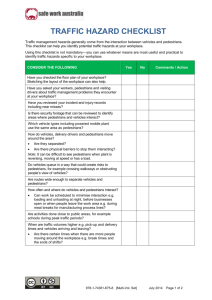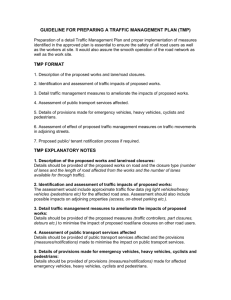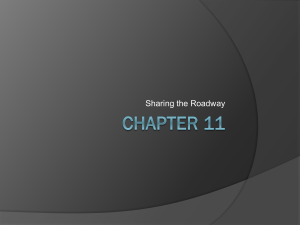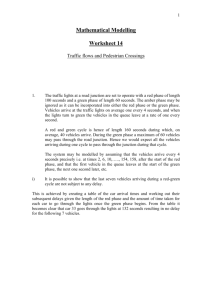Traffic management guide - Shopping centres
advertisement
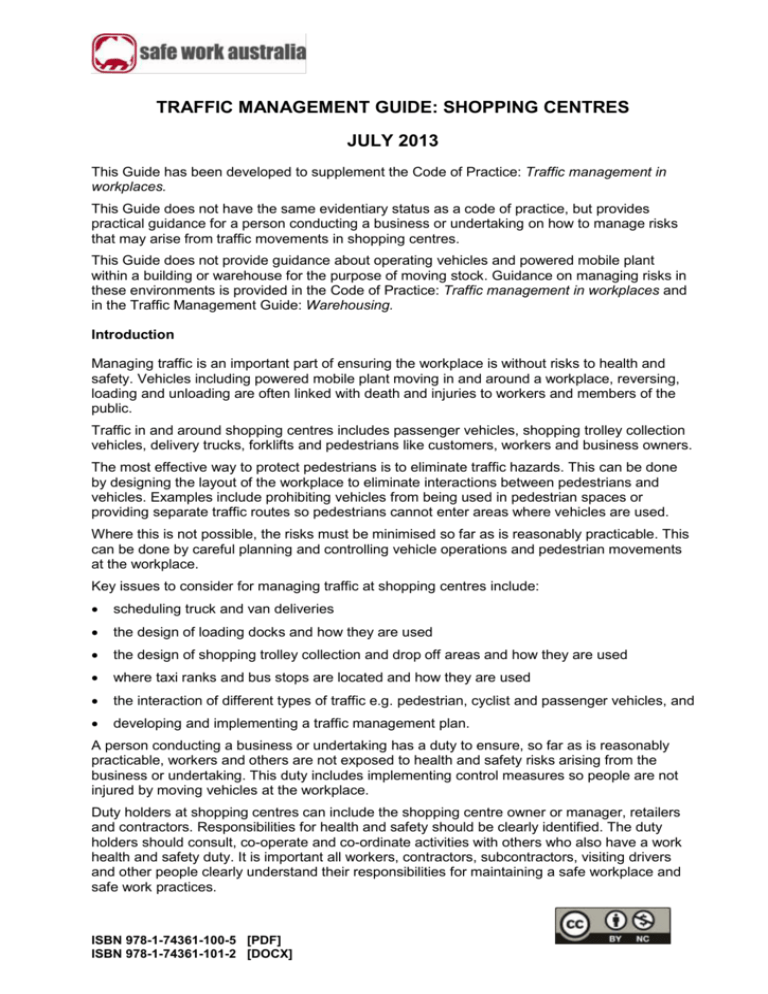
TRAFFIC MANAGEMENT GUIDE: SHOPPING CENTRES JULY 2013 This Guide has been developed to supplement the Code of Practice: Traffic management in workplaces. This Guide does not have the same evidentiary status as a code of practice, but provides practical guidance for a person conducting a business or undertaking on how to manage risks that may arise from traffic movements in shopping centres. This Guide does not provide guidance about operating vehicles and powered mobile plant within a building or warehouse for the purpose of moving stock. Guidance on managing risks in these environments is provided in the Code of Practice: Traffic management in workplaces and in the Traffic Management Guide: Warehousing. Introduction Managing traffic is an important part of ensuring the workplace is without risks to health and safety. Vehicles including powered mobile plant moving in and around a workplace, reversing, loading and unloading are often linked with death and injuries to workers and members of the public. Traffic in and around shopping centres includes passenger vehicles, shopping trolley collection vehicles, delivery trucks, forklifts and pedestrians like customers, workers and business owners. The most effective way to protect pedestrians is to eliminate traffic hazards. This can be done by designing the layout of the workplace to eliminate interactions between pedestrians and vehicles. Examples include prohibiting vehicles from being used in pedestrian spaces or providing separate traffic routes so pedestrians cannot enter areas where vehicles are used. Where this is not possible, the risks must be minimised so far as is reasonably practicable. This can be done by careful planning and controlling vehicle operations and pedestrian movements at the workplace. Key issues to consider for managing traffic at shopping centres include: scheduling truck and van deliveries the design of loading docks and how they are used the design of shopping trolley collection and drop off areas and how they are used where taxi ranks and bus stops are located and how they are used the interaction of different types of traffic e.g. pedestrian, cyclist and passenger vehicles, and developing and implementing a traffic management plan. A person conducting a business or undertaking has a duty to ensure, so far as is reasonably practicable, workers and others are not exposed to health and safety risks arising from the business or undertaking. This duty includes implementing control measures so people are not injured by moving vehicles at the workplace. Duty holders at shopping centres can include the shopping centre owner or manager, retailers and contractors. Responsibilities for health and safety should be clearly identified. The duty holders should consult, co-operate and co-ordinate activities with others who also have a work health and safety duty. It is important all workers, contractors, subcontractors, visiting drivers and other people clearly understand their responsibilities for maintaining a safe workplace and safe work practices. ISBN 978-1-74361-100-5 [PDF] ISBN 978-1-74361-101-2 [DOCX] The person with management or control of a shopping centre should contact the regulator and the road authority for advice on traffic control requirements, particularly where these interact with public road systems. Information, training, instruction and supervision A person conducting a business or undertaking has a duty to provide any information, training, instruction or supervision necessary to protect all persons from risks to their health and safety. A person conducting a business or undertaking must ensure, so far as is reasonably practicable, all workers including contractors, know and understand the traffic rules, safety policies and procedures for the workplace. Visiting delivery drivers should be aware of the site traffic safety rules and procedures. Other people at the workplace, like customers and visitors, must take reasonable care for their own health and safety and must take reasonable care not to adversely affect other people’s health and safety. They must comply, so far as they are reasonably able, with reasonable instructions given by the person conducting the business or undertaking to allow that person to comply with the WHS Act. Truck and van deliveries, loading docks and scheduling To manage health and safety in loading and unloading areas consider: excluding the public by separating trucks and vans from customers and other pedestrians by using barriers, guard rails or designated loading docks e.g. a security gate house to prevent unauthorised entry installing physical barriers around walkways leading to waste areas controlling or limiting vehicle access to loading docks using a queuing time slot system for entry to a workplace with large volume trucks designing separate entry and exit points for large vehicles using a gatehouse for traffic control and managing time slot scheduling preventing general public access to high traffic areas and clearly displaying signs prohibiting unauthorised access installing convex mirrors to improve visibility for drivers and pedestrians limiting truck and van speeds by using traffic calming devices or speed limits clearly marking walkways, vehicle parking and loading bays establishing schedules for using loading docks to reduce how often heavy vehicles and pedestrians interact e.g. bin and compactor waste should be picked up when shopping centres are closed or when the volume of public traffic is low providing walkways with physical barriers to storage areas to protect pedestrians who order and pick up goods and transfer the goods to retail stores providing waste management programs consulting with affected parties, and monitoring the loading dock to help assess the effectiveness of control measures. Loading docks should be designed or changed to avoid the need for vehicles to reverse, especially where pedestrians and other vehicles may be nearby. The design should ensure everyone in the loading dock has clear visibility of the whole work area. Traffic Management Guide: Shopping Centres Page 2 of 4 Shopping trolley collection Where trolley collection activities are contracted to another business, duty holders should communicate, consult and work together in a co-operative and co-ordinated way to manage the risks. To manage health and safety risks from collecting shopping trolleys consider: using trolley collection vehicles with design features which give the driver clear visibility and warn others of the vehicle’s presence including: o reversing cameras or mirrors which minimise blind-spots o expanded mesh tailgates to improve visibility when reversing o reversing alarms or beepers o strobe-type warning lights and reversing lights o bright colours or safety tape on vehicle vertical ramps ensuring high-visibility or reflective clothing is worn by workers implementing a preventative inspection and maintenance system for collection vehicles conducting a manual handling risk assessment to ensure moving trolleys do not place the worker at risk of injury and trolleys being manually moved do not create a traffic hazard, and providing information, instruction, training and supervision to workers about how to use collection vehicles safely. Taxi ranks and bus stops There should be clearly designated areas for taxi ranks and bus stops. Where possible their design should eliminate the need for these vehicles to reverse. Taxi ranks and bus stops should be placed in areas separate from other vehicles, where possible. Install signs which clearly mark the direction of vehicle travel, pedestrian crossings and speed limits. Building footpaths to guide pedestrians to bus stops and taxi ranks may also help separate pedestrians from vehicles. Pedestrian, cyclist and passenger vehicle traffic To manage pedestrian, cyclist and passenger vehicle traffic consider: developing a pedestrian and cycling plan that includes separate walkways and cycle routes – the more direct these are the more likely pedestrians and cyclists will use them ensuring the cycling plan includes separate cycle storage areas away from loading dock areas and other mobile plant. Separate walkways should be provided for pedestrians accessing the cycle storage areas ensuring cycle lanes are connected to major cycle paths encourages cyclists to use them widening footpaths to allow people with prams, shopping trolleys and electric scooters to be able to easily pass each other locating parking for parents with prams, the elderly and disabled away from major traffic flows but as close as possible to pedestrian entrances, exits and crossings regularly monitoring and maintaining footpaths to minimise trip hazards Traffic Management Guide: Shopping Centres Page 3 of 4 quickly removing obstructions caused by building works or parked vehicles, and implementing warning and traffic signs and enforcing speed limits. Traffic management plans A traffic management plan documents and helps explain how risks will be managed in the workplace. A planning process should be established and tasks identified and allocated, together with corresponding responsibilities. In preparing the traffic management plan, a plan or sketch of the workplace and traffic area layout can help traffic designers and the traffic management consultative committee identify hazards and risks. A traffic management plan may include details of: pedestrian, cyclist and traffic routes traffic control measures for each expected interaction including drawings of the layout of barriers, walkways, signs and general arrangements to warn and guide traffic around, past, or through the workplace or temporary hazard how often and where vehicles and pedestrians will interact including the types of pedestrians expected to be present at various times of the day e.g. when school-aged children may be in the area the responsibilities of people managing traffic in the workplace the responsibilities of people expected to interact with traffic in the workplace instructions or procedures for controlling traffic including in an emergency, and how to implement and monitor the effectiveness of a traffic management plan. Whenever possible a shopping centre owner or manager should consult with relevant people including retailers and contractors on the development of a traffic management plan. The traffic management plan should be monitored and reviewed regularly including after an incident to ensure it is effective and takes into account changes at the workplace. In centres with a traffic management consultative committee, the committee should conduct the monitoring and review. Workers should be aware of and understand the traffic management plan and receive information, instruction, training and supervision. Site induction should include the traffic management plan. More information More information on how to manage traffic at a workplace is provided in the Code of Practice: Traffic management in workplaces. Further guidance on consultation is provided in the Code of Practice: Work health and safety consultation, co-operation and co-ordination. Further guidance on the risk management process is provided in the Code of Practice: How to manage work health and safety risks. Codes of practice and other resources are provided on the Safe Work Australia website. Traffic Management Guide: Shopping Centres Page 4 of 4
